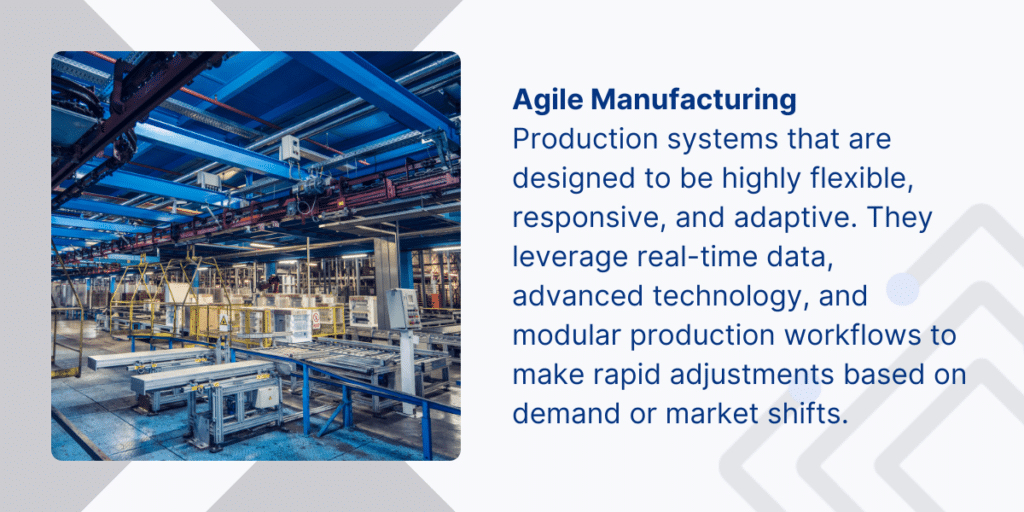Staying competitive requires not just the ability to produce but the agility to respond quickly to shifting customer demands, market changes, and supply chain disruptions. This is where agile manufacturing comes into play. By prioritizing flexibility, speed, and responsiveness, agile manufacturing systems enable manufacturers to adapt to real-time changes, ensuring that production is always aligned with the latest market conditions.
What Are Agile Manufacturing Systems?
Definition of Agile Manufacturing
Agile manufacturing refers to production systems that are designed to be highly flexible, responsive, and adaptive. Unlike traditional manufacturing, which often focuses on fixed production processes and large batch sizes, agile manufacturing systems leverage real-time data, advanced technology, and modular production workflows to make rapid adjustments based on demand or market shifts.
Key Components of Agile Manufacturing Systems
- Real-time Data: With immediate access to operational data, manufacturers can make faster and more informed decisions to meet customer needs and production schedules.
- Automation and Robotics: Smart technologies such as robotics and automation play a significant role in streamlining processes and increasing flexibility by reducing manual labor and human error.
- Modular Production Systems: Production lines are designed to quickly switch between different products, enabling manufacturers to adjust output based on demand.
- Examples of Agile Manufacturing: Companies in industries like automotive and electronics have successfully implemented agile manufacturing systems. For example, Toyota has long been an advocate of agile manufacturing, responding to supply chain changes and customer preferences with great speed and precision.

What Are the Core Concepts of Agile Manufacturing?
Agile manufacturing isn’t just about technology; it’s a holistic approach to rethinking how manufacturers operate. Several core principles underpin agile manufacturing systems:
- Customer Focus: At the heart of agile manufacturing is a commitment to meeting customer needs quickly. This requires reducing time-to-market and offering the ability to customize products without sacrificing efficiency.
- Example: Companies that allow customers to personalize their orders, such as Nike’s customization options for shoes, benefit from agile manufacturing systems that can quickly adjust production to meet these demands.
- Flexibility: Agile systems are built to quickly adapt production schedules and processes to real-time demand. This flexibility helps manufacturers remain resilient when unexpected disruptions occur, such as supply chain issues or sudden surges in demand.
- Example: A manufacturer of consumer electronics might alter production schedules during holiday seasons to meet higher demand for specific models or features.
- Collaboration and Communication: Agile manufacturing relies on strong collaboration between cross-functional teams, including design, engineering, and production. Effective communication tools enable these teams to act quickly to align production goals and resolve issues.
- Example: Real-time collaboration between departments ensures that engineers and production teams are aware of design changes and can adjust manufacturing processes accordingly.
- Technology Integration: The use of advanced technologies such as the Internet of Things (IoT), artificial intelligence (AI), and machine learning allows manufacturers to monitor their production in real time, improving both the speed and accuracy of decision-making.
- Example: Predictive maintenance systems, which use sensors and AI, can predict when machines need maintenance, reducing downtime and improving operational efficiency.
- Continuous Improvement: Agile manufacturing involves a commitment to constant evaluation and improvement. By regularly analyzing data and production metrics, manufacturers can identify inefficiencies and innovate their processes.
- Example: A continuous feedback loop between production teams and customers can help identify areas for product improvement or process enhancements.
What Is Lean and Agile Manufacturing?
Lean Manufacturing
Lean manufacturing is a production strategy that focuses on eliminating waste, improving quality, and optimizing efficiency. By streamlining processes, reducing excess inventory, and minimizing non-value-added activities, lean manufacturing aims to make production as cost-effective and efficient as possible.
Agile Manufacturing
Agile manufacturing, on the other hand, prioritizes flexibility, speed, and the ability to quickly adjust to changes. While it may involve some trade-offs in terms of efficiency, agile manufacturing provides manufacturers with the capability to respond rapidly to customer demands and market shifts.
Lean Manufacturing vs Agile Manufacturing
While both lean and agile manufacturing share the goal of improving production, their strategies differ. Lean focuses on eliminating waste and optimizing efficiency, whereas agile emphasizes flexibility and adaptability.
- Lean: Focuses on reducing waste and improving efficiency, but may struggle to respond quickly to unexpected changes or disruptions.
- Agile: Focuses on adapting to changes in real time, allowing companies to quickly shift production strategies to meet changing customer demands.
Complementary Nature of Lean and Agile
When combined, lean and agile principles can provide a balanced approach. Lean ensures that resources are used efficiently, while agile enables a quick response to changing conditions. A high-performing manufacturing system can integrate both to optimize cost efficiency without sacrificing flexibility.
Benefits of Agile Manufacturing
Agile manufacturing offers numerous advantages that help manufacturers stay ahead and overcome challenges in an increasingly competitive marketplace. These benefits go beyond simply improving efficiency and cost-effectiveness; they enable companies to thrive in dynamic, rapidly changing environments.
1. Faster Time-to-Market
Agile manufacturing systems are designed to respond quickly to changing demands and market conditions. By leveraging real-time data and flexible production processes, companies can adjust their operations quickly, leading to shorter lead times. The ability to make immediate production changes ensures that products reach customers faster, which is crucial in a competitive environment where market opportunities can be fleeting. Rapid response times allow manufacturers to be more nimble, increasing their ability to capitalize on new product trends, address customer demands, and deliver timely solutions.
2. Increased Customer Satisfaction
Customer satisfaction is directly influenced by a company’s ability to meet specific needs and deliver products on time. Agile manufacturing enables companies to provide greater customization options, responding quickly to shifting customer requirements. By adapting production processes to meet varying demands, manufacturers can offer tailored solutions that enhance customer loyalty. Moreover, agile systems improve product availability, ensuring that customers receive the products they want, when they want them. This responsiveness helps companies build stronger, long-term relationships with their clients, which is crucial for maintaining competitive advantage in the marketplace.
3. Better Risk Management
The manufacturing landscape is fraught with uncertainties, such as supply chain disruptions, fluctuations in demand, and other external factors that can impact production schedules. Agile manufacturing offers a proactive approach to managing these risks by enabling companies to adapt quickly to unforeseen challenges. Through flexible production systems and real-time data, businesses can adjust resources, reallocate workforce capabilities, and shift production schedules to mitigate the impact of these disruptions. This adaptability helps manufacturers avoid downtime, maintain consistent production levels, and minimize the financial impact of unexpected events.
4. Enhanced Innovation
Agile manufacturing encourages a culture of continuous improvement and innovation. The flexibility inherent in agile systems allows manufacturers to experiment with new ideas, technologies, and processes. As market demands evolve and new technologies emerge, agile systems make it easier to integrate changes without disrupting the entire production workflow. This openness to change promotes creativity and enables manufacturers to innovate both in product development and in operational processes. Continuous feedback loops and data-driven insights further fuel this culture of innovation, ensuring that manufacturers can stay ahead of competitors and adapt to industry trends.
5. Cost Efficiency
While implementing agile manufacturing may involve initial investments in flexible technologies and training, it can lead to long-term cost savings. Agile systems optimize resource allocation by allowing companies to quickly adjust production volumes, reduce excess inventory, and minimize waste. This ability to adapt to demand fluctuations ensures that manufacturers do not overproduce or hold unnecessary stock, leading to cost reductions. Agile systems also help prevent costly stockouts, as they enable manufacturers to respond to customer orders quickly and adjust production schedules to meet demand without creating excess. In the long run, these efficiencies contribute to a more streamlined and cost-effective operation.
6. Increased Workforce Engagement
Agile manufacturing fosters a collaborative work environment, where cross-functional teams play an essential role in decision-making and problem-solving. This collaboration empowers employees to contribute ideas, adjust processes, and help implement improvements that align with evolving production needs. As a result, employees feel more engaged in the process and have a greater sense of ownership over the success of the operation. Empowered workers who can make real-time adjustments or suggest improvements are more likely to be motivated and invested in the company’s success. This engagement not only enhances productivity but also leads to a more positive workplace culture, which can improve overall job satisfaction and reduce turnover rates.

Embracing Agile Manufacturing for Long-Term Success
In a world where customer expectations are higher than ever, agility is no longer a luxury—it’s a necessity. Agile manufacturing equips companies with the tools and strategies to quickly adapt to changing demands, reduce lead times, and stay ahead of the competition. By integrating lean and agile principles, manufacturers can achieve both operational efficiency and the flexibility needed to thrive in a dynamic market.
As manufacturers assess their current production strategies, adopting agile systems is crucial to maintaining a competitive edge in the rapidly evolving marketplace. The ability to respond swiftly to customer needs and market conditions will be a decisive factor in securing long-term success.
At Indeavor, we understand that agility in workforce management plays a pivotal role in agile manufacturing systems. Our solutions provide real-time visibility, strategic scheduling, and empower manufacturers to quickly adjust their workforce to meet production demands.
By optimizing labor management alongside your agile production strategy, Indeavor helps ensure that your manufacturing operations remain adaptable, efficient, and responsive to ever-changing market conditions. Consider partnering with Indeavor to enhance your manufacturing agility and stay ahead in the competitive landscape.
About the Author
Claire Pieper is the Digital Marketing Specialist for Indeavor. In her role, she specializes in crafting strategic and engaging content, ensuring that customers are well-informed. Claire is dedicated to enhancing the customer experience and optimizing the user journey through Indeavor’s solutions. To learn more or get in touch, connect with Claire on LinkedIn.







